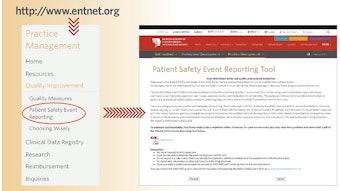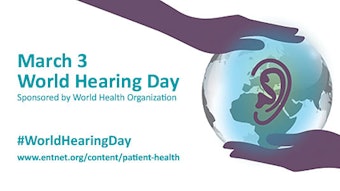Make a choice, cherish your voice
From the moment we wake up in the morning to the second we fall asleep, we all make tens of thousands of choices. Simple decisions are made, such as what to wear based on the weather, expected activities of the day, and the status of laundry.
James J. Daniero, MD, MS; Assistant Professor Director, Laryngology and Voice Care; Department of Otolaryngology-Head and Neck Surgery, University of Virginia
Download the World Voice Day 2018 poster

Share the poster featured here with your patients and spread the word about the importance of a healthy voice. Visit www.entnet.org/worldvoiceday to print your 2018 poster and access other World Voice Day resources.
- Go to www.entnet.org/worldvoiceday to access the high-resolution print file.
- Choose a size:
- Small: 17.3″ x 11.75″
- Medium: 24″ x 18″
- Large: 36″ x 24″
- Upload the file to your local office supply store’s website or save the file and take it to the store for printing.
- Display in your office!
Here are a few vendors you may choose from:
- print.staples.com/posters.aspx
- customprinting.officedepot.com
- or try a local drug store.
From the moment we wake up in the morning to the second we fall asleep, we all make tens of thousands of choices. Simple decisions are made, such as what to wear based on the weather, expected activities of the day, and the status of laundry. More complex decisions are made, such as when to fit exercise into the weekly routine and how to manage stress within the week. Each individual choice has associated downstream effects, with the collective result of these choices impacting the state of our minds and bodies to varying degrees in either a positive or negative way. As with our total body health, a vocally healthy lifestyle involves making life choices and establishing positive behavioral interventions. Consequently, these healthy choices prime the environment for atraumatic and efficient voice production.
In addition, each of us has a unique vocal signature comparable to a vocal fingerprint. The voice includes defining characteristics of pitch, loudness, resonance, and clarity. The unique permutation of these characteristics is distinctly recognizable, closely associated with our identity, and therefore should be something that we cherish when navigating the many thousands of choices that we make daily. Simple interventions such as voice conservation, hydration, and humidification allow for efficient laryngeal biomechanics by increasing vocal fold pliability and creating a low-friction system. Moreover, keeping our minds and bodies “in-tune” helps to maintain the same within our larynges. For example, many laryngeal disorders result from a mind-body disconnect, such as paradoxical vocal fold motion (voice cords move incorrectly), muscle tension dysphonia (straining as in hoarseness), and functional aphonia (inability to speak). These conditions can often be successfully treated by a voice-trained speech-language pathologist utilizing behavioral techniques including biofeedback, vegetative tasks, and mindfulness. Furthermore, the systemic manifestations of sicca (dryness) and inflammation lead to chronic laryngeal injury that can be addressed by proper hydration and diet modification. For those individuals that are unable to resolve laryngopharyngeal reflux with diet modification, a trial of antireflux medications may be required to avoid chronic laryngeal damage. Making our vocal health a priority involves making the choice to eat healthier, quit smoking, and limit alcohol consumption, which also have the benefit of being systemic health improvements.
Finally, the manner in which we use our voices has direct correlation with the state of our vocal folds. Phonation (making sound), even in moderate doses, leads to minor vocal fold epithelial (outer tissue) damage; however, with a proper amount of rest, the body’s natural wound repair mechanisms restore the vocal tissue to its proper state. Therefore, an appropriate balance between environmental damage, voice-induced trauma, and repair must be maintained to avoid cumulative (increasing) injury. A negative balance may result in a variety of phonotraumatic lesions, such as scar, vocal polyps, or nodules. Maintaining this balance is yet another example of healthy choices that help to preserve vocal health. Recognizing this critical relationship gives us the tools to cherish our voices by making the right choices.
You can cherish your voice by making these healthy choices:
- Drink plenty of water each day
- Limit coffee, caffeinated tea, and soda
- Avoid vocal overuse and abuse
- Quit smoking, avoid the use of smokeless tobacco, and limit exposure to secondhand smoke
- Treat associated acid reflux
- Manage stress appropriately
It is with a focus on these healthy choices that we celebrate World Voice Day 2018 with the theme “Make a Choice, Cherish your Voice.”










